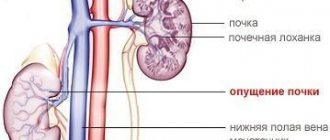Kinds
Depending on the cause of development, primary idiopathic nephrotic syndrome and secondary glomerulopathies are distinguished. The following types of primary idiopathic nephrotic syndrome are distinguished:
- minimal change disease;
- membranous glomerulopathy;
- focal segmental glomerulosclerosis;
- membrane-proliferative (mesangiocapillary) glomerulonephritis;
- other proliferative glomerulonephritis.
Secondary nephrotic syndrome occurs within the framework of the following pathology:
- Infections (infectious endocarditis, syphilis, leprosy, hepatitis B and C, mononucleosis, cytomegalovirus infection, chickenpox, HIV, malaria, toxoplasmosis, schistosomiasis);
- Use of medications and narcotic drugs (gold preparations, penicillamine, bismuth preparations, lithium, probenecid, high doses of captopril, paramethadone, heroin);
- Systemic diseases (systemic lupus erythematosus, Sharpe's syndrome, rheumatoid arthritis, dermatomyositis, Henoch-Schönlein purpura, primary and secondary amyloidosis, polyarteritis, Takayasu's syndrome, Goodpasture's syndrome, dermatitis herpetiformis, Sjögren's syndrome, sarcoidosis, cryoglobulinemia, ulcerative colitis;
- Metabolic disorders (diabetes mellitus, hypothyroidism, familial Mediterranean fever);
- Malignant neoplasms (Hodgkin's disease, non-Hodgkin's lymphoma, chronic lymphocytic leukemia, multiple myeloma, malignant melanoma, carcinoma of the lung, colon, stomach, breast, cervix, ovary, thyroid and kidney);
- Allergic reactions (insect bites, hay fever, serum sickness);
- Congenital diseases (Alport syndrome, Fabry disease, sickle cell anemia, alpha1-antitrypsin deficiency).
Nephrotic syndrome can sometimes develop in patients suffering from preeclampsia, IgA nephropathy, and renal artery stenosis.
The morphological classification of nephrotic syndrome according to the ICD includes the following forms of kidney pathology:
- minor glomerular disorders;
- focal and segmental glomerular damage;
- membranous glomerulonephritis;
- mesangial proliferative glomerulonephritis;
- diffuse endocapillary proliferative glomerulonephritis;
- diffuse mesangiocapillary (membranoproliferative) glomerulonephritis;
- dense sediment disease;
- diffuse crescentic glomerulonephritis;
- Kidney amyloidosis.
According to the activity of the process, complete, partial remission and relapse are distinguished - newly emerging proteinuria after complete remission or an increase after partial remission.
Determination of the state of kidney function in nephrotic syndrome is based on 2 indicators: glomerular filtration rate and signs of renal damage. Kidney damage is structural and functional changes in the kidneys that are detected by blood tests, urine tests, or imaging tests.
1.General information
It is better to start getting acquainted with any medical topic with terminology. This may also apply to other areas of knowledge, but issues of health and illness, on the one hand, concern literally each of us (and many are not interested in curiosity), and on the other hand, they are described in a complex, highly specialized language based on Greek and Latin roots, where most terms have a number of synonyms and, in addition, can completely change their meaning due to a single letter. Therefore, sometimes it takes a lot of time to clear up the confusion: it turns out that “nephrotic” and “nephritic” are not a typo, but two different syndromes, of which the first is still sometimes called the outdated term “nephrosis”, and the second is identified with glomerulonephritis... However, let's start in order.
Nephrotic syndrome is a broad complex of symptoms associated with renal dysfunction (hence the root "nephro-"), blood disorders and severe swelling. Note that the term “syndrome” implies more than just the sum of its constituent symptoms; This is a pathological condition that is characterized by integrity, recognizable clinical specificity and its own patterns of occurrence, development, transformation and outcome. Nephrotic syndrome (like any other) can be formed under the influence of many factors and/or observed in very different diseases, but its clinical structure remains unchanged and can be described as an independent symptom complex, which was done about a hundred years ago by Academician E. M. Tareev, an outstanding Soviet doctor who stood at the origins of several areas of modern domestic medicine.
In nephrotic syndrome, the glomerular, glomerular filtering system of the kidneys is predominantly affected. The same can be said about nephritic syndrome, but in this case a specific etiology is implied (glomerulonephritis, inflammation of the glomeruli), while nephrotic syndrome, or nephrosis, is a general pathology of the kidneys, the etiopathogenesis and clinical manifestations of which are much wider.
A must read! Help with treatment and hospitalization!
Causes
Some people substitute the concepts nephrotic and nephritic syndrome. In medicine, these concepts are divided. Thus, nephrotic syndrome is characterized by kidney damage. With nephritic syndrome, an inflammatory process and other associated symptoms develop.
The development of nephritic syndrome is associated with the penetration of antigens from the blood into the renal structures. After their penetration into the kidneys, immune mechanisms are activated, and an immune response to the foreign body occurs. Nephritic syndrome can develop due to the following reasons:
- viral or bacterial infection;
- autoimmune diseases;
- the effect of radiation;
- after administration of a vaccine or serum;
- tumor development;
- toxic effects after drinking alcohol or taking drugs;
- vascular damage due to diabetes;
- intoxication of the body with chemicals of various classes;
- chronic pathologies of the urinary tract;
- increased physical activity;
- sudden changes in air temperature.
Nephritic syndrome can develop both against the background of an inflammatory process and non-infectious disorders - depending on this, treatment tactics are developed.
The multidisciplinary Yusupov Hospital employs experienced specialists who accompany the patient during the treatment process. Thus, if this syndrome is of an autoimmune nature, consultation with a rheumatologist is necessary. Make an appointment
Acute nephritic syndrome
Nephritic syndrome in its acute form develops rapidly, the patient has protein and blood in his urine, in addition, swelling appears, and the rate of filtration performed by the glomeruli decreases. Acute nephritic syndrome can develop against the background of systemic diseases, for the treatment of which you should contact a rheumatologist, who sees patients daily at the Yusupov Hospital. Infectious disease agents can also provoke the appearance of a complex of symptoms.
Acute nephritic syndrome is manifested by unpleasant and painful sensations, which should be a serious reason to contact a specialist. Patients who need emergency care can go to the Yusupov Hospital at any time of the day. If serious problems are detected in the patient, emergency hospitalization is carried out.
Symptoms
With nephritic syndrome, patients with typical complaints come to the Yusupov Hospital. Signs of nephritic syndrome are:
- the appearance of blood in the urine;
- change in the color of urine - it becomes purple;
- the formation of edema, the most pronounced swelling of the face, eyelids, legs in the evening;
- feeling of thirst and slow urine production.
- A pathological process in the kidneys can cause the following symptoms in patients:
- weakness, nausea;
- pain in the lumbar region that appears at night;
- headaches that appear when the body weakens;
- signs of infectious respiratory diseases;
- Body temperature rises extremely rarely.
Acute nephritic syndrome develops 7-10 days after exposure to a provoking factor or infection. When the first signs of pathological kidney function appear, you should use the services of specialists from the Yusupov Hospital and visit the diagnostic class=”aligncenter” width=”1024″ height=”682″[/img]
Symptoms of nephrotic syndrome
Nephrotic syndrome is characterized by symptoms that are clear enough to detect it at home and consult a doctor in a timely manner:
- swelling of the eyelids, puffiness of the face;
- sallow skin color, pallor;
- swelling of the genitals, lower back;
- peeling of the skin, dryness and microcracks.
Liquid may ooze from the cracks. Swelling spreads throughout the body if treatment is not started in time. The most dangerous sign is the accumulation of fluid in the internal organs: the pericardium, pleural and abdominal cavity.
During laboratory diagnostics, low levels of protein in the blood and high levels of protein in the urine are determined. Characterized by increased blood clotting and low albumin concentration. If you notice one or more symptoms, make an appointment with a urologist to prevent complications.
Diagnostics
During an outpatient examination of patients with nephrotic syndrome, doctors at the Yusupov Hospital carry out the following basic diagnostic measures:
- clinical blood test;
- general urine analysis;
- biochemical blood test (total protein, albumin, urea, creatinine, K, Na, Ca, glucose and cholesterol levels in blood serum);
- calculation of glomerular filtration rate using the Cockcroft-Gault formula;
- enzyme immunoassay for viral hepatitis B and C;
- blood test for HIV;
- Ultrasound examination of the kidneys and abdominal organs.
Additional diagnostic examinations that are carried out on an outpatient basis include daily proteinuria or protein/creatinine, albumin/creatinine ratios, immunological methods for studying blood serum, and determining the concentration of Cyclosporin-A in the blood serum.
If necessary, a computed tomography scan can be performed. Upon admission of a patient to the therapy clinic, nephrologists at the Yusupov Hospital prescribe the following mandatory diagnostic examinations:
- kidney biopsy;
- complete blood count (before and after kidney biopsy);
- general urinalysis (before and after kidney biopsy);
- daily proteinuria or protein/creatinine, albumin/creatinine ratios;
- ultrasound examination of the kidneys (after biopsy);
- coagulogram;
- morphological diagnosis of kidney tissue biopsy;
- immunohistochemistry.
Patients have the opportunity to undergo complex studies at partner clinics located in Moscow.
Additional diagnostic examinations that are carried out at the hospital level include electron microscopy of kidney tissue biopsy, determination of cryoglobulins in blood serum, electrophoresis of urine proteins, immunofixation of blood proteins for paraproteins, determination of the concentration of Cyclosporin-A in blood serum. If necessary, sternal puncture, fibroendogastroscopy, colonoscopy, and radiography of the flat bones of the skull can be performed. According to indications, computed tomography, Doppler ultrasound scanning of renal vessels is performed, and the level of tumor markers in biological fluids is determined. If a toxic origin of nephrotic syndrome is suspected, the presence and concentration of bismuth, lithium, paramethadone, and heroin in the blood are determined.
The patient is advised by specialized specialists depending on the suspected cause of nephrotic syndrome:
- oncologist - if paraneoplastic nephropathy is suspected;
- phthisiatrician – if a specific process is suspected;
- rheumatologist – if a systemic disease is suspected.
An ophthalmologist examines the fundus of the eye. The surgeon is invited for a consultation in case of nephrotic crises to exclude acute surgical pathology. A consultation with a neurologist is prescribed if neurolupus or systemic vasculitis is suspected. A hematologist examines patients with suspected multiple myeloma, a light chain disease. If a patient with nephrotic syndrome has a prolonged fever, he or she is consulted by an infectious disease specialist. Differential diagnosis of nephrotic syndrome is carried out with diseases that occur with severe edematous syndrome: liver cirrhosis, congestive chronic heart failure.
Diagnosis of nephritic syndrome
Nephritic syndrome during the initial examination may be suspected by a specialist when studying the patient’s complaints and external signs. The results of research and laboratory tests will refute or confirm the alleged diagnosis:
- biochemical analysis of blood in the case of nephritic syndrome reveals a violation of water-salt, lipid and protein balance;
- urine analysis may reveal leukocytes, red blood cells and protein;
- a blood test may reveal a decrease in compliment activity and leukocytosis;
- Ultrasound is performed to identify pathological changes in the kidneys.
Auxiliary methods for diagnosing nephritic syndrome are: CT and MRI, radiography and kidney biopsy. The specialists of the Yusupov Hospital Therapy Clinic have the necessary knowledge and means to provide patients with medical care at the European level. To undergo an examination at the Yusupov Hospital, you do not need to abandon your planned activities and spend time in queues; by contacting the staff by phone, you can choose a convenient time to visit the diagnostic center.
Treatment
Treatment of nephritic syndrome has the following goals:
- achieving weakening or disappearance of signs of the disease;
- elimination of extrarenal symptoms (arterial hypertension, edema) and complications (electrolyte disturbances, infection, nephrotic crisis);
- slowing the progression of chronic kidney disease and delaying its terminal stage with the help of dialysis and kidney transplantation.
The patient, depending on the severity of nephrotic syndrome, is recommended free or bed rest (if the patient’s condition is serious and there are complications). Dosed physical activity – 30 minutes 5 times a week. Doctors recommend that patients stop smoking and drinking alcohol. The diet is balanced, with an adequate amount of protein (1.5-2g/kg), caloric intake according to age. In the presence of arterial hypertension and edema, limit the use of table salt (less than 1-2g per day).
Pathogenetic therapy after establishing a morphological diagnosis begins in the therapy clinic and continues on an outpatient basis. Significant edema is treated with diuretics. Diuretics are not prescribed for diarrhea, vomiting, or hypovolemia. For long-term edema, furosemide is prescribed intravenously as a single bolus or torasemide orally. To treat patients with refractory edema, a combination of loop and thiazide-like or potassium-sparing diuretics is used. If there is a high risk of developing nephrotic crisis, a combination of albumin and diuretics is used.
If the patient experiences resistant edema in combination with renal failure in the acute period of nephrotic syndrome, hemodialysis with ultrafiltration is performed until the critical state of renal failure is eliminated and diuresis appears.
Cardiologists at the Yusupov Hospital take a differentiated approach to the choice of treatment method for patients with nephritic syndrome. In the absence of symptoms of acute kidney injury, ACE inhibitors or angiotensin AT1 receptor blockers are prescribed for antihypertensive purposes, but not in combination. If high blood pressure persists, calcium channel blockers are used. If the patient has a rapid pulse or there are signs of chronic heart failure, beta blockers are additionally prescribed.
Pathogenetic therapy of nephritic syndrome depends on the morphological variant. It is prescribed only after a kidney biopsy and clarification of the morphological diagnosis.
When treating the disease, the disease that caused the nephrotic syndrome is also treated. If parasites or helminths are detected, antiparasitic (anthelminthic) drugs are prescribed. Patients with neoplasms undergo chemotherapy, radiation treatment, and surgery. For diabetic nephropathy, endocrinologists treat diabetes mellitus, nephrologists prescribe drugs that have a nephroprotective effect.
At the onset of nephrotic syndrome, patients are prescribed methylprednisolone or prednisolone. Upon achieving complete or partial remission, the dose of prednisolone is gradually reduced.
Patients who do not achieve complete or partial remission after taking a full dose of prednisolone for 16 weeks are defined as steroid-resistant. They are treated with combination therapy with cyclosporine-A and a minimal dose of prednisolone.
50-75% of patients with nephrotic syndrome who respond to steroid therapy experience relapses. If nephrotic syndrome reoccurs, prednisolone is prescribed. If relapses occur three or more times within one year or there is a steroid-dependent form, combination therapy with low doses of prednisolone in combination with one of the following groups of drugs is used:
- alkylating agents;
- calcineurin inhibitors;
- antimetabolites.
Patients with nephrotic syndrome and chronic kidney disease are prescribed statins. For resistant nephrotic syndrome, rituximab is used. Treatment of nephrotic syndrome in systemic lupus erythematosus is carried out depending on the class of lupus nephritis.
The pathogenetic treatment started in the therapy clinic is continued in the patient’s outpatient and home settings under monthly monitoring of the results of laboratory data (clinical blood test, general urine test, biochemical blood test). Proteinuria levels are monitored using test strips once every 1-2 weeks, and patients regularly measure blood pressure. If the amount of proteins in the urine increases, the protein/creatinine ratio is determined and immunosuppressive therapy is adjusted. If the patient does not respond to immunosuppressive therapy, a repeat kidney biopsy is performed in a therapy clinic.
If the cause of nephrotic syndrome is infectious diseases, antibiotic therapy is administered. Drugs are selected for each patient individually depending on the type of infectious agent. At a high risk of arterial and venous thrombosis, low molecular weight heparins are administered subcutaneously for a long time.
Treatment of acute nephritic syndrome at the Yusupov Hospital
When treating nephritic syndrome, the main task of specialists is to eliminate the root cause that caused its development, as well as the accompanying symptoms. Patients with this complex of manifestations are indicated for inpatient treatment, in which medications are used, nutrition and drinking regimen are adjusted, and the amount of urine produced over a certain time period is also noted.
In cases where nephritic syndrome is caused by an inflammatory process, patients are advised to take antibacterial drugs. In addition, medications may be prescribed to maintain kidney function and reduce circulating blood volume. Specialists at the Yusupov Hospital include in the treatment plan only those products that are registered in the Russian Federation.
Patients undergoing treatment at the Yusupov Hospital not only receive high-quality medical services, but also the friendly attitude of the staff. The coziness and comfort created since the opening of the medical institution is preserved and supported by employees every day. Patients who are in a comfortable environment and experience psychological well-being more quickly achieve positive results in the treatment of nephritic syndrome.
If you are concerned about manifestations of kidney dysfunction or other specialists have identified nephritic syndrome, you can seek help from specialists at the Yusupov Hospital Therapy Clinic, who can be booked by phone.











